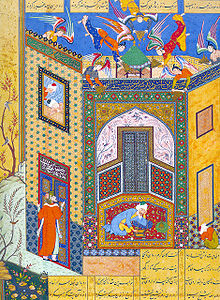This is an old revision of this page, as edited by SouthernComfort (talk | contribs) at 15:23, 13 April 2006 (grammar and copyedits to intro). The present address (URL) is a permanent link to this revision, which may differ significantly from the current revision.
Revision as of 15:23, 13 April 2006 by SouthernComfort (talk | contribs) (grammar and copyedits to intro)(diff) ← Previous revision | Latest revision (diff) | Newer revision → (diff)

From the Haft Awrang of Jami, in the story "A Father Advises his Son About Love." See Nazar ill'al-murd Smithsonian Institution, Washington, DC.
Nur ad-Din Abd ar-Rahman Jami (August 18, 1414–November 19, 1492) is considered to have been the greatest Persian poet of the 15th century and the last great Sufi poet of Persia. His fame rests even more on his mystical authority than on his talents as a poet and writer.
Biography
He was born in a village near Jam, but a few years after his birth, his family migrated to the cultural city of Herat in present-day Afghanistan where he was able to study Peripateticism, mathematics, Arabic literature, natural sciences, and Islamic thought at the Nizamiyyah University of Herat.
Afterwards he went to Samarqand, the most important centre of scientific studies in the Islamic World and completed his studies there. He was a famous Sufi, and a follower of the Naqshbandiyyah sufi Order. At the end of his life he was living in Herat.
His teachings
In his role as Sufi shaykh, Jami expounded a number of teachings regarding following the Sufi path. In his view, love was the fundamental stepping stone for starting on the spiritual journey. To a student who claimed never to have loved, he said, "Go and love first, then come to me and I will show you the way."
However, the use of "forbidden" themes such as the love of boys or the love of wine in Sufi teachings such as Jami's has been the topic of lively debate, with some claiming that the references are purely symbolic and mystical, and others holding that they are the expression of authentic feelings and desires, whether or not they were actually acted upon.
His works

Another illustration from the Haft Awrang
Jami wrote approximately eighty-seven books and letters, some of which have been translated into English. His works range from prose to poetry, and from the mundane to the religious. He has also written works of history. His poetry has been inspired by the ghazals of Hafez, and his Haft Awrang is, by his own admission, influenced by the works of Nizami.
In his Nafahat al-Uns (Breaths of Fellowship), a biography of Sufi saints, he defends some of the greatest Persian mystics against accusations that their practice of shahid-bazi (the "witness-game", the contemplation of beautiful boys) is heretical. Among these are Al-Ghazali, Awhad al-Din Kirmani, and Farhruddin Iraqi. His argument was that the masters were absorbed in absolute beauty, and not trapped by the base form. In the cosmogony evolved by Jami, God himself is but a beautiful youth absorbed in the contemplation of his many qualities.
One source claims that Jami's view – a variation from the norm, – was that one should not discriminate against youths who were more mature: "Is it not the same youth as last year? ... It is true that he has increased in stature and his body is more vigorous. What impudence, what shame, what irreverence to cease to visit him and to desire his company." Jami himself was a practitioner of shahid-bazi, though he seems to have evaded being suspected of heresy.
Divan of Jami
Among his works are:
- Baharistan (Abode of Spring) Modeled upon the Gulistan of Saadi
- Nafahat al-Uns (Breaths of Fellowship) Biographies of the Sufi saints
- Haft Awrang (Seven Thrones) His major poetical work
- Lawa'ih A treatise on Sufism
- Diwanha-i Sehganeh (Triplet Divans)
See also
Notes
- William Chittick, "Jami on Divine Love and the image of wine", in Studies in Mystical Literature, 1/3 (1981), pp. 193-209
- "The Will Not to Know" in Murray and Roscoe, Islamic Homosexualities, NY, 1997; p.125
- ibid., p.23
References
- E.G. Browne. Literary History of Persia. (Four volumes, 2,256 pages, and twenty-five years in the writing). 1998. ISBN 0-700-70406-X
- Jan Rypka, History of Iranian Literature. Reidel Publishing Company. ASIN B-000-6BXVT-K
External links
- Jami on PoetryPortal
- Jami on Iran Chamber Society Website
- Jami's Yusuf and Zulaikha: A Study in the Method of Appropriation of Sacred Text</ref>